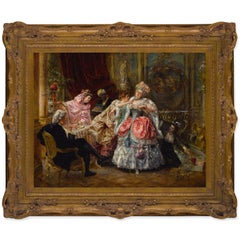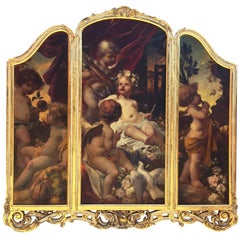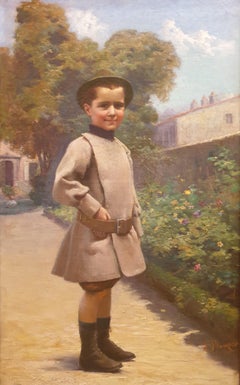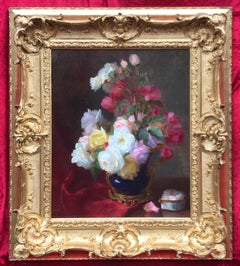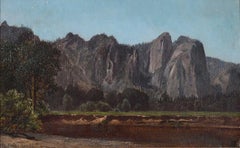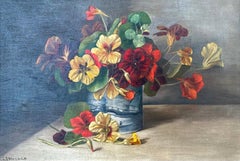Academic Art
During the Renaissance, the first European fine art academies were established in Italy and would guide the style and standards of visual culture in the following centuries. Academic art became dominant across the continent in the 17th century, with artists coming together to offer instruction in this style of painting and sculpture.
The academic art period represented a significant change from the previous era when painters, sculptors and other artists were part of guilds and seen more as artisans than purveyors of culture. While patronage from the elite and the church remained pivotal, young artists were able to support themselves for the first time through academic exhibitions and an independent marketplace. The leading academies included the French Académie Royale de Peinture et de Sculpture founded in Paris in 1648 (which became the Académie des Beaux-Arts after the French Revolution) and the London Royal Academy of Arts formed in 1768 under the inaugural leadership of painter Joshua Reynolds.
Academy students sketched drawings based on prints, sculptures and, finally, live models. Movements including neoclassicism and romanticism were particularly popular in these art schools and institutions where the influence of Raphael and Nicolas Poussin was prominent. Beaux Arts architecture and furniture design drew on these movements, too, and, as they also originated at the Académie des Beaux-Arts, the disciplines share common ground with academic painting and sculpture.
Although academic art was a major shift for artistic status when it began, by the middle of the 19th century it was viewed as stodgy and resistant to new ideas, with the subject matter of artists such as William-Adolphe Bouguereau and Jean-Léon Gérôme generally limited to allegorical or mythological themes. Impressionism, realism and the other movements that engaged with contemporary issues that followed were direct reactions to the academic tradition, although it continued to inform the avant-garde as artists like Gustav Klimt and Pablo Picasso started their practices as academic realists.
Find a collection of academic paintings, sculptures, prints and more art on 1stDibs.
Early 1900s Academic Art
Wood, Oil
Late 19th Century Academic Art
Oil
Early 20th Century Academic Art
Oil
Early 1900s Academic Art
Oil
1870s Academic Art
Canvas, Oil, Board
1890s Academic Art
Canvas, Oil
1860s Academic Art
Marble
1880s Academic Art
Canvas, Oil
19th Century Academic Art
Canvas, Oil
1970s Academic Art
Watercolor, Archival Paper
Early 20th Century Academic Art
Oil
2010s Academic Art
Oil, Panel
Early 20th Century Academic Art
Canvas, Oil
Late 19th Century Academic Art
Canvas, Oil
Late 20th Century Academic Art
Watercolor, Pencil
Early 20th Century Academic Art
Lithograph
19th Century Academic Art
Bronze
19th Century Academic Art
Oil
1950s Academic Art
Oil, Canvas
19th Century Academic Art
Canvas, Oil
1790s Academic Art
Marble
Late 19th Century Academic Art
Oil
1880s Academic Art
Oil
1890s Academic Art
Canvas, Oil
1880s Academic Art
Watercolor
2010s Academic Art
Oil, Panel
Early 20th Century Academic Art
Oil
1870s Academic Art
Canvas, Oil
19th Century Academic Art
Canvas, Oil
1990s Academic Art
Woodcut
Late 19th Century Academic Art
Oil
20th Century Academic Art
Limestone
2010s Academic Art
Canvas, Oil
19th Century Academic Art
Canvas, Oil
19th Century Academic Art
Oil
1920s Academic Art
Bronze
19th Century Academic Art
Plaster
1880s Academic Art
Ink
1890s Academic Art
Oil
19th Century Academic Art
Oil
1930s Academic Art
Canvas, Oil
Early 20th Century Academic Art
Canvas, Oil
1870s Academic Art
Watercolor
1860s Academic Art
Canvas, Oil
1930s Academic Art
Precious Stone
20th Century Academic Art
Limestone
21st Century and Contemporary Academic Art
C Print
21st Century and Contemporary Academic Art
Cotton Canvas, Oil
Late 19th Century Academic Art
Oil
2010s Academic Art
Canvas, Oil
Early 20th Century Academic Art
Photographic Paper
2010s Academic Art
Canvas, Oil
19th Century Academic Art
Oil
1930s Academic Art
Etching
Late 19th Century Academic Art
Oil
Mid-19th Century Academic Art
Bronze
1880s Academic Art
Lithograph
Mid-19th Century Academic Art
Paper, Graphite
Late 19th Century Academic Art
Oil
19th Century Academic Art
Canvas, Oil
